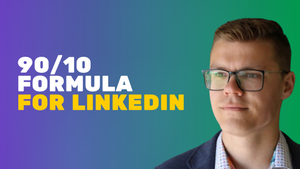What happens when a drug goes viral on social media? Take a look at the current shortage of Ozempic and other GLP-1 agonists, and you'll see the impact.
In the midst of this chaos, it's easy to overlook how social media can actually empower patients with better information, often through the experiences shared by other patients.
Enter the patient influencers. While this concept might seem a bit controversial in Europe, in the US, it's becoming a common tool in the pharma marketing arsenal.
There's a lot to unpack about patient influencers, with both positive and negative aspects. I won’t pretend to have all the answers to this complex issue, but I will at least try to shed some light on what’s happening and why you should care.
The rise of patient influencers
The idea of patients sharing information about their health online isn't new—it likely dates back to the early days of the internet. However, in recent years, especially with the increased awareness of health issues brought on by the COVID pandemic, many patients have embraced their roles as educators, leading to a surge in “mini-influencers” who regularly share their experiences with specific conditions.
Naturally, the pharmaceutical industry took notice and for the past few years, drug marketers have been actively collaborating with patient influencers.
But before diving into that, let's clear up some regulatory details. As someone living in Europe, the notion of pharma companies paying individuals to promote their drugs on social media felt quite disturbing and that’s because promoting prescription drugs to consumers is basically illegal here.
Direct-to-consumer (DTC) advertising for prescription drugs is only allowed in the US and New Zealand. In the US, seeing drug ads on TV or billboards is standard, but this is unthinkable in Europe, where pharma companies tread carefully.
Heck, DTC advertising is so lucrative in the US that it’s one of the largest spending categories in advertising, totalling $6.58 billion in 2020.
Regulating social media advertising is trickier than TV ads, and we’ll revisit this point later but before we dive in, it’s important to recognize the stark cultural differences in how pharma companies engage with patients on either side of the Atlantic.
With that out of the way, let's try to understand how things work in the US, since that's where the most data is available.
Patient influencers are here to stay
The literature on patient influencers is still limited, but a study published in 2023 by researchers from the University of Colorado Boulder provides some insights. The researchers conducted in-depth interviews with 26 patient influencers from various ethnic backgrounds and with different health conditions, identified through the Health Union agency.
My first criticism is that the sample size is too small to draw any scalable conclusions, but the results are still interesting and tell us a lot about the general trends in patient influencer circles.
One interesting finding is that almost all participants (24 out of 26) shared health-related information on their social profiles to make sure others were getting informed about their conditions. This trend is likely to scale well, as the motivation to share such information often comes from a desire to help others.
Also, 38% of the participants were actively involved with nonprofit organizations related to their conditions, organized support groups, and raised money for research, which shows how dedicated they are to patient advocacy.
But here's the icky part: the study also found that 69% (18 out of 26) of participants worked with for-profit brands and pharmaceutical companies. This shows a big connection between influencers and drug manufacturers in the US. It's not clear if all were paid to promote prescription drugs, but some definitely were, even though most participants said they were just trying to help their followers.
Another thing the study found is that 23% of participants talked about prescription drugs with their followers via direct messages. This makes it hard to know how much influence they really have as those conversations aren’t public. The potential for misinformation is also concerning, especially since only 12% of these influencers declared reading medical studies.
Erin Willis, one of the study's authors, stated in an article:
“The bottom line here is that patient influencers act as a form of interactive direct-to-consumer advertising, sharing their knowledge and experiences on pharmaceutical drugs with communities of followers in which they wield great influence.”
Despite these concerns, the study concludes with a positive note:
“The current status of health literacy in the United States is concerning, especially coupled with the digital literacy of younger generations. However, patient influencers potentially bridge a gap in the health care system and offer information and advice in laypeople’s terms or in a way that is culturally relevant; frequently, there is an exchange and opportunity to ask questions when patient influencers connect with other patients on the web without fear of stigma or shame. Many chronic disease self-management education programs use peer educators to deliver the curriculum or program, and so, perhaps patient influencers provide opportunities to reimagine patient education and health education programs.”
This study only scratches the surface of patient influencers, but I think it's a solid start. It shows how a genuine desire to help has led to this new type of influencer and how the pharma industry is starting to recognize their potential.
Patient influencers: a good return on investment
A reason why patient-influencer marketing is here to stay is the recognized effectiveness of these channels for promoting health-related products.
According to recent data shared by Ogilvy Research and Intelligence with MM+M, “70% of people reported following or seeking out health-related social media accounts or have learned about health or medical issues from social media accounts.”
The article also adds that “of those who are engaged with health-related social media accounts, 92% cited a positive impact and 47% reported health-related social media accounts have made it easier to learn about health conditions.”
It looks like social media drug advertising is following the same playbook that pharma companies have been using for TV ads since the 80s. Basically, the idea is to promote prescription drugs directly to consumers, so they get familiar with the brand names and bring it up during a consultation with their physicians, who in most cases will prescribe them what they ask.
"Something like a third of consumers who've seen a drug ad have talked to their doctor about it," says Julie Donohue, a professor of public health at the University of Pittsburgh in an NPR article. "About two-thirds of those have asked for a prescription. And the majority of people who ask for a prescription have that request honored."
A major difference from TV ads, though, is the use of micro-influencers instead of relying on big celebrity names.
For her study, Erin Willis interviewed influencers with between 1,000 and 40,000 followers because, as she explains, “such ‘micro influencers’ tend to be less expensive for advertisers to work with than celebrities, and research has shown they have the most influence on purchasing behaviors.”
Indeed, a survey from 2020 showed that 51% of the people surveyed “completely or mostly trusted patient influencers”, with 85% of them saying they would be very or somewhat receptive to an ad from a patient influencer promoting a drug related to the patient’s condition.
But what about Europe or other countries where DTC advertising isn’t allowed?
This is a complicated topic with many caveats because each country has a different regulation when it comes to promoting drugs on social media.
In the Canadian province of Québec, for instance, the law is quite nuanced and open to interpretation. In principle, DTC advertising for prescription drugs is illegal, unless the indication isn't revealed. As a result, it’s not uncommon to see influencers promoting drugs in Québec, but they often keep the information shallow, which can pose a risk of misinformation in itself.
Other countries are much more stringent. For example, France passed a new law on June 9th 2023 strictly limiting what influencers can promote on social media, making it illegal for French influencers to promote prescription drugs.
But what happens when a miracle drug promises to make you lose weight without effort?
GLP-1 agonists change the game
I won’t go into too much detail about the GLP-1 agonist craze, because by now you’ve probably heard about Ozempic, Wegovy, and their competitors (and it would take me another 3,000 words to unpack this topic).
The key point to remember is that the widespread promotion of these drugs by celebrities and lifestyle influencers has led to manufacturers struggling to keep up with demand. This results in a shortage for the people who genuinely need these drugs: persons with diabetes.
To give you an idea of the scale, the New York Post reported last March that “TikTok, for example, is being flooded with videos of users testifying to wellness through prescription drugs, with hashtags like #adhd (22.3B views), #ozempic (675.1M views) and #wegovy (259.3M views) consistently trending as of late.” By now, those GLP-1 hashtags have likely passed the billion-view mark and are catching up with #adhd (which by the way, is also flooded with dubious companies trying to profit from patients).
While the problem is most visible in the US, it is rapidly spreading worldwide. Due to their unique mechanism, GLP-1 agonists have completely changed the game for patient influencers.
As Fierce Pharma reported last month:
“A new report notes that while typical condition-focused healthcare influencers have niche online followings in the ‘hundreds to low thousands,’ with minimal opportunities for monetization, many GLP-1 influencers have follower counts in the hundreds of thousands, with millions of ‘likes’ and, in some cases, enough paid content opportunities to make a living. “
Rita Glaze-Rowe, President of Transformative Healthcare Markets at Real Chemistry, the company behind the report cited by Fierce also explains:
“If you believe GLP-1 agonists for obesity treatment are just another class of pharmaceutical products, you need to take a closer look at the transformation that is unfolding.”
The report also notes that these new GLP-1 influencer have “online behaviors, content creation momentum and monetization approaches that mirror what has been seen with the beauty and fashion influencer community, rather than with healthcare influencers. This new phenomenon is putting additional strain on an already complex patient-healthcare provider relationship and creating pressure for marketing and communication teams to create new ways to engage, educate and activate.”
Rather than identifying as “obesity patients,” this new class of influencers is categorizing themselves as “GLP-1 users,” a behavior unseen with any other prescription drugs so far.
The craze has also led many influencers to get involved in discussions about how to get these drugs, sometimes using barely legal methods.
If you think we’ve seen the worst, be prepared for more. Real Chemistry reports that GLP-1 drug prescriptions for obesity patients have skyrocketed by around 72% from last year. However, considering the 52 million diagnosed obese individuals in the US, that’s only 3.5% of the market. What will happen when the number of patients climbs to 5%, 10%, or more?
A call for more regulation
Call me boring, but I'll end on a note about regulation because I believe in ethical marketing, especially in science. And if the GLP-1 craze isn’t enough to get the drug regulators’ attention, I don’t know what will.
The FDA guidance on social media marketing hasn’t been updated since 2014! Social media channels are barely recognizable from what they were ten years ago, so it might be a good time to act.
Fortunately, some countries are starting to react. The Prescription Medicines Code of Practice Authority in the UK recently updated its social media guidance for pharmaceutical companies. In France, as I mentioned earlier, a new law regulates influencer advertising, covering all types of promotion, not just pharmaceuticals.
Even though DTC advertising is illegal in Europe and patient influencers are under closer scrutiny, enforcement is challenging. It barely took me a minute to find a TikTok video of a Belgian person explaining how to get Ozempik in Belgium.
What’s not forbidden, however, is common sense and empathy for patients.
My view is that pharma marketers and communicators should just try to help patients as much as they can, and there's no law that says you can't do that.
It should be standard practice in the industry to create a direct communication channel with patient groups, help them understand their condition better, and provide them with precise, unbiased information.
Banning prescription drug advertising isn’t necessarily a bad thing for the industry. It just means that you have to help patients understand their condition and the science that can help them, rather than just telling them which drugs to take.
The University of Boulder study showed that patient influencers are mainly posting to help others and it’s also the industry’s responsibility to make sure they’re well-informed and unbiased.



![Maximizing your conference impact with LinkedIn: A step-by-step guide [with post templates]](https://images.unsplash.com/photo-1512736912-cd9db1d90b72?crop=entropy&cs=tinysrgb&fit=max&fm=jpg&ixid=M3wxMTc3M3wwfDF8c2VhcmNofDY2fHxjb25mZXJlbmNlJTIwaGFsbHxlbnwwfHx8fDE3Mzc1NDA4OTd8MA&ixlib=rb-4.0.3&q=80&w=300)


